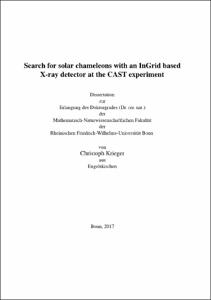Krieger, Christoph: Search for solar chameleons with an InGrid based X-ray detector at the CAST experiment. - Bonn, 2018. - Dissertation, Rheinische Friedrich-Wilhelms-Universität Bonn.
Online-Ausgabe in bonndoc: https://nbn-resolving.org/urn:nbn:de:hbz:5n-51412
Online-Ausgabe in bonndoc: https://nbn-resolving.org/urn:nbn:de:hbz:5n-51412
@phdthesis{handle:20.500.11811/7603,
urn: https://nbn-resolving.org/urn:nbn:de:hbz:5n-51412,
author = {{Christoph Krieger}},
title = {Search for solar chameleons with an InGrid based X-ray detector at the CAST experiment},
school = {Rheinische Friedrich-Wilhelms-Universität Bonn},
year = 2018,
month = aug,
note = {Chameleons are particles with a density dependent effective mass and couplings to matter as well as photons. They are introduced in modifications to General Relativity involving scalar fields and aiming at explaining Dark Energy, which is needed for the observed self-accelerated expansion of the universe. Chameleons can be produced in the tachocline region of the Sun. On Earth these solar chameleons can be detected by axion helioscopes such as the CERN Axion Solar Telescope (CAST) where they are converted into low energy X-ray photons inside a strong magnet pointed towards the Sun. Due to weak couplings corresponding to a very low number of expected signal events, X-ray detectors with low background rates and high efficiency are required. In this thesis an X-ray detector based on the GridPix technology, a pixelized readout combined with an integrated gas amplification stage, was developed and built. This detector, which features a low energy threshold and allows for an eventshape based background suppression, was characterized at a variable X-ray generator and afterwards commissioned at CAST behind an X-ray telescope. From the data taken at CAST in 2014 and 2015 with this detector an improved upper bound on the chameleon photon coupling was derived.},
url = {https://hdl.handle.net/20.500.11811/7603}
}
urn: https://nbn-resolving.org/urn:nbn:de:hbz:5n-51412,
author = {{Christoph Krieger}},
title = {Search for solar chameleons with an InGrid based X-ray detector at the CAST experiment},
school = {Rheinische Friedrich-Wilhelms-Universität Bonn},
year = 2018,
month = aug,
note = {Chameleons are particles with a density dependent effective mass and couplings to matter as well as photons. They are introduced in modifications to General Relativity involving scalar fields and aiming at explaining Dark Energy, which is needed for the observed self-accelerated expansion of the universe. Chameleons can be produced in the tachocline region of the Sun. On Earth these solar chameleons can be detected by axion helioscopes such as the CERN Axion Solar Telescope (CAST) where they are converted into low energy X-ray photons inside a strong magnet pointed towards the Sun. Due to weak couplings corresponding to a very low number of expected signal events, X-ray detectors with low background rates and high efficiency are required. In this thesis an X-ray detector based on the GridPix technology, a pixelized readout combined with an integrated gas amplification stage, was developed and built. This detector, which features a low energy threshold and allows for an eventshape based background suppression, was characterized at a variable X-ray generator and afterwards commissioned at CAST behind an X-ray telescope. From the data taken at CAST in 2014 and 2015 with this detector an improved upper bound on the chameleon photon coupling was derived.},
url = {https://hdl.handle.net/20.500.11811/7603}
}






